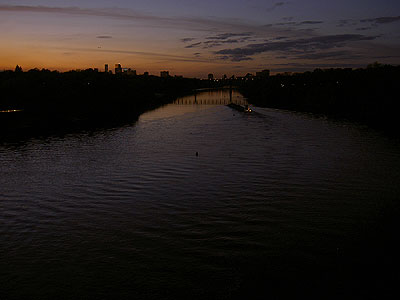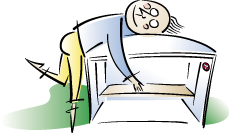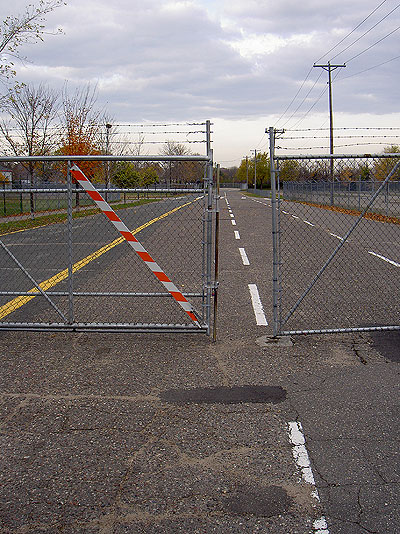
If you were an Amazing Precision Cyclist you could zoom right through this, but I stopped and walked the bike through. You can see how tight a fit this is, keeping in mind I have broad 48cm handlebars.
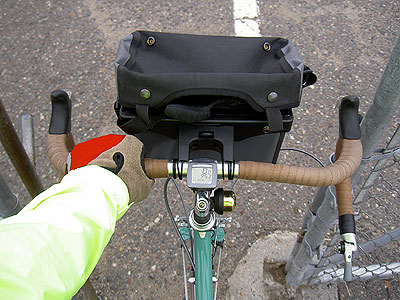
Then you can ride off through the Fairgrounds, largely empty and vacant this time of year. If you go west, you pass by the University of Minnesota's Saint Paul Campus farm fields. These cows were in the field, basically equidistant between the Minneapolis and Saint Paul downtowns.
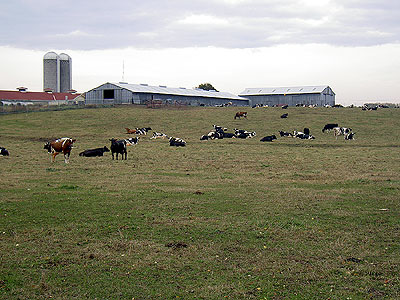
This one wasn't too interested in a mere cyclist.
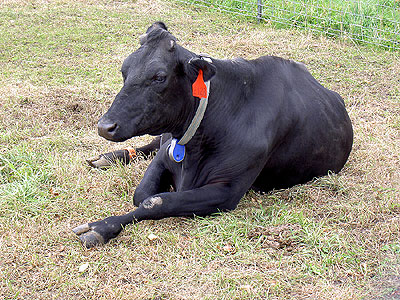
I rode on through the Fairgrounds...
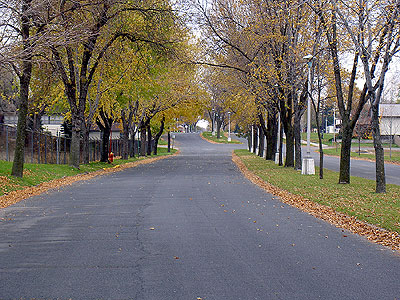
...onto Raymond and down south of University. The store I'd gone to visit, Viking Safety Products, was closed. Bummer! The phone book said they were open Saturday 9-12, and I've been there before on a Saturday morning. Oh well.
I set off eastbound, wanting to stop by the Sibley Bike Depot. I rode down Grand Avenue most of the way, where the stores must have been doing some Halloween promotion since there were lots of little kids in costumes on the sidewalks.
I wanted to pop into Sibley to see what they had lying around for three-speed bikes. I had run into the Lake Pepin Three-Speed Tour site and separately tracked down Pashley Cycles. I knew the Pashley name from the 2001 Encycleopedia where a lovely seven-speed Harrod's Light Roadster was listed. It said it was made by Pashley. We were in London that fall of 2001 and stopped by Harrods. I nipped up to the bicycle section but none of these lovely bikes was in evidence. They'd also discontinued their excellent Harrods-brand curry powder so it was a disappointing visit all around.
What I didn't realize was that Pashley was a Stratford-upon-Avon based maker of bicycles, including the ones used by the Royal Mail. Stratford's right in the heart of my family country and I even had three great-aunts who moved there after being bombed out of Coventry by the Germans in 1940. I stayed with them several times in my youth in a lovely house out on Tiddington Road backing up to the Stratford Golf Club. They ran a high-end ladies shop in Bridge Street, less than a mile from where Pashley is located. These great aunts are all dead now but on our 2001 trip we were visiting family in Redditch and Coventry, both very close to Stratford. Next time over I'm going to have to visit Pashley.
The particular item of interest in the Pashley Roadster in the 24.5" frame size for, as they put it, "the taller gent". The frame is pretty big, I guess, and it has a double top-tube. The 24.5" frame sounds smallish (the Atlantis is a 27") but it is designed for gentlemen with a 35" to 39" inseam, right in my range. Maybe the 28" wheels lift it higher. There is a Sovereign option which I believe makes it a 5-speed (still internal hub gears) and also adds a hub generator. You knock off the VAT but add shipping and I'm guessing this bike would run me $1,100. It's tough to justify blowing a grand on a 5-speed bike that weighs probably 45 pounds when I have this delightful Atlantis, but I harbor a secret desire to get one. I can't take the Atlantis on the Three Speed Tour even if I promise to just use three of the gears. Thus, my trek to Sibley.
It would be great to report that they had a Pashley for the taller gent sitting there for $25 but of course they didn't, and the three-speeds they had in stock were all tiny-framed. I chatted for a while with the guys at the Depot about bikes. One of them had a pretty nifty Schwinn he was using around town, a 10-speed with fenders, upright bars and some decent folding wire baskets. This was interesting, but it was no three-speed, so I moved on.
My next destination was Sam's Warehouse Club. We're members but don't go there all that often. However, I have always liked to give away full-sized candy bars at Halloween, and a box of 36 is about $13-14 at Sam's. I had never ridden my bike there before and hadn't tried to get from downtown Saint Paul to Maplewood, either. I rode off up 9th Street, which curved around and ran parallel to I-35E. After about a mile, I crossed under the Interstate and got on the Gateway Trail, a bike trail that runs out to the Saint Croix River north of Stillwater.

Here, though, it runs along and then over the Interstate along an old railway right of way. This cuts diagonally northeast through this part of the city, showing you the backyards of lots of homes and businesses. There are a couple of very heavy-duty circa 1918 bridges. I only went as far as Keller Lake, then got off and rode up Arcade past Gervais Lake, on up to Lahore and then east on County D. I needed to get to Highway 61 and cross under I-694. County D was closed for construction. Closed? That's for cars and girlie-men! I rode on up. As it happened, there were only a couple of hundred yards of torn up road. I wallowed down through the dirt to Highway 61, across the near lanes of traffic, through the grassy median and across the distant lanes. This got me under I-694 and onto Buerkle Road, which took me over to Sam's.
Sam's doesn't have bicycle parking. I'd harangue them for it, especially given Wal Mart's sudden desire to be seen as green, but this is a store where people buy stuff by the pallet-load. Also, the lack of a bike rack is no worse than, say, World Cycling Productions or any number of bicycle shops. I locked my bike to a handy sign and took my panniers (a Jandd and a Breezer grocery-bag pannier) in with me to make sure I didn't buy more than I could fit.
When you buy compact, high-value stuff, it doesn't take long to get $108 worth of merchandise into two grocery panniers. I was distressed that they didn't have Mounds bars, having to settle for Rolos, Salted Nut Rolls and Kit Kats, plus some deli meats, smoked salmon, granola bars, etc. I checked out, loaded up the bike and rode home much the same way I came, wallowing back up the construction zone on my small chainring with unclipped feet and getting off the Gateway Trail at Arlington to make my way home. In all, I did 35 miles or so, the part from Sam's including about 24 pounds of merchandise in the panniers.
This is the trail near Keller Lake. It looks like an old rail right of way here.

Here's the Atlantis loaded with my purchases.

